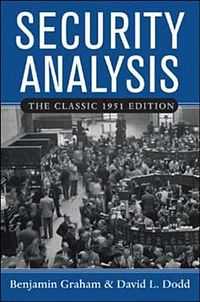Security Analysis (book)
| Security Analysis | |
|---|---|
 | |
| Author | Benjamin Graham & David Dodd |
| Language | English |
| Subject | Finance, Investing |
| Publisher | McGraw-Hill |
Publication date | 1934 |
| ISBN | 0-07-144820-9 |
| OCLC | 57429180 |
| Dewey Decimal | 332.63/2042/0973 22 |
| LC Class | HG4521 .G67 2005 |
Security Analysis is a book written by professors Benjamin Graham and David Dodd of Columbia Business School, which laid the intellectual foundation for what would later be called value investing. The work was first published in 1934, following unprecedented losses on Wall Street. In summing up lessons learned, Graham and Dodd chided Wall Street for its myopic focus on a company's reported earnings per share, and were particularly harsh on the favored "earnings trends." They encouraged investors to take an entirely different approach by gauging the rough value of the operating business that lay behind the security. Graham and Dodd enumerated multiple actual examples of the market's tendency to irrationally under-value certain out-of-favor securities. They saw this tendency as an opportunity for the savvy.
Fundamentally, Security Analysis stands for the proposition that a professionally trained investor can determine the intrinsic value of a company from a full financial analysis of the corporation, make purchases in stocks when the market price is selling below its value, and earn a satisfactory return based upon Graham's margin-of-safety principle. Warren Buffett, the only student in Graham's investment seminar to earn an A+,[1] made millions of dollars by methodically and rationally implementing the tenets of Graham and Dodd's book early in his career.[citation needed].
Security Analysis is still used as a textbook at Columbia. The book also represents the genesis of financial analysis and corporate finance. However, in the 1970s Graham stopped advocating a careful use of the techniques described in his text for security analysts in selecting individual stock investments, citing that "in the light of the enormous amount of research now being carried on, I doubt whether in most cases such extensive efforts will generate sufficiently superior selections to justify their cost. To that very limited extent I'm on the side of the "efficient market" school of thought now generally accepted by the professors." This statement was made by Graham under the belief, that the "average manager" of an investment trust cannot consistently beat the average return of the market because "In effect that would mean that the stock market experts as a whole could beat themselves- a logical contradiction" and that for most investors in general "to achieve superior results is harder than it looks."[2] Instead, he later suggested the use of one or two simple criteria for the investor's entire portfolio, focusing on results of the group rather than on individual securities.[3]
Domestic editions of Security Analysis
- 1st ed. (1934) Whittlesey House (the trade division of McGraw-Hill) - LCCN: 34023635
- Black bound cover (1st printing) was printed by The Maple Press Co., York, PA, for a small distribution in the United States
- Maroon bound cover (2nd printing) was published that same year for sale abroad, The Maple Press Co., York, PA
- 2nd ed. (1940) McGraw-Hill - LCCN: 40013028
- 3rd ed. (January 1, 1951) McGraw-Hill (last edition while Graham & Dodd were faculty members of Columbia) - LCCN: 2005270180
- 4th ed. (1962) McGraw-Hill (last edition by Graham & Dodd) Charles Sidney Cottle (1910–1987) joins as coauthor - LCCN: 62017368
- Reprint 3rd ed. (May 1976) McGraw-Hill - ISBN 0-07-023957-6
- 5th ed. (January 1, 1988) McGraw-Hill (updated by Cottle, Murray, and Block) - ISBN 0-07-013235-6
- Reprint 1st ed. (October 1, 1996) McGraw-Hill - ISBN 0-07-024496-0
- Reprint 1st ed. (February 1, 1997) McGraw-Hill - ISBN 0-07-024497-9
- Reprint 2nd ed. (October 10, 2002) McGraw-Hill - ISBN 0-07-141228-X
- Reprint 3rd ed. (December 10, 2004) McGraw-Hill - ISBN 0-07-144820-9
- 6th ed. (September 4, 2008) McGraw-Hill (updated with commentary by 10 contributors) - ISBN 0-07-159253-9
- Limited Leatherbound Edition (September 19, 2008) McGraw-Hill - ISBN 0-07-162357-4
References
- ↑ Alice Schroeder: "The Snowball: Warren Buffett and the Business of Life", Page 149. Random House Large Print, 2008.
- ↑ The Intelligent Investor, Benjamin Graham
- ↑ Financial Analysts Journal. A Conversation With Benjamin Graham. 1976.